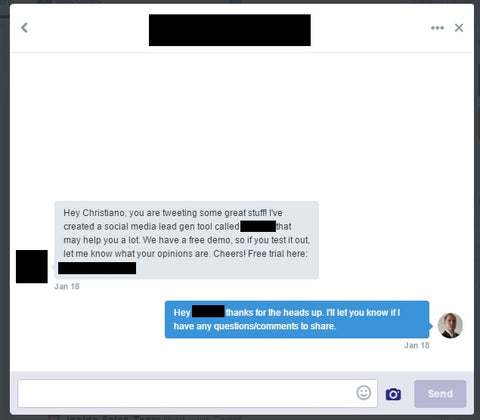What marketing automation means for Twitter
First, automation can be fantastic with immense potential to:
- Reduce costs
- Increase service quality
- Enable small business to scale affordably
The tools themselves remain neutral as their potential becomes realized by how companies use them.
Of course, realization of potential precludes marketing automation executed properly...
Consider dynamite designed to "blow things up." Its application in a cave or a grocery store determines whether we consider someone a miner or a terrorist.
Automation (minus risk to life) is just like dynamite.
What happens when you mix "dynamite" (automation) with Twitter? Well, that depends on how we use automation and determine whether a company is seen as inauthentically spamming or proactive in relevantly communicating.
The problem? The intent behind marketing automation affects the decisions we make in how we use automation.
People think that marketing automation automatically creates leads. While possible, what remains overlooked lies in intent. We often find ease and convenience prioritized in lieu of relevant and preemptive communication with convenience as the by-product.
This makes a huge difference. Notice these three screenshots of a conversation on Twitter:
Part 1:

Part 2:

Part 3:

The problem? "We are doing very well with it."
What about those automatically receiving these unsolicited messages? Have we not learned our lessons from the auto-dialer?
Customer-centric focus precludes effective automation. This includes both the companies that make automation tools and those that use them.
Out of curiosity, I signed up for the mentioned automation tool to assess its functionality. No method existed to effectively execute dynamic behavioral targeting.
Even if companies wanted to cater messaging to behavior, the tool does not offer that choice.
Was this an oversight? Well, luckily I had another Twitter conversation with the founder of one of these automated tools:
Part 1:

Please note the above screenshot contains our Twitter conversation history in its entirety.
No response.
In an effort to share feedback (solicited by the CEO), I sent a LinkedIn InMail to the CEO. See below:
Part 2: Follow-up on LinkedIn

As of Feb. 2, 2016 - no response.
How can companies execute on automation properly when those that create the very tool do not?
Some might ask then, "how can we use automation?"
Simple. Automate as a response to a behavior. If someone watches your webinar half way through, sending them a message soliciting feedback to the webinar (if they went) makes sense. Sending a different message if they didn't go, would also make sense.
For simpler automation, why not ask a question about them rather than about you?
For example, I am a management consultant. Now, if I chose to use Twitter automation, I might target someone who has "small business owner" in their profile description. That message could look like:
"Looking to connect as I consult SMB owners. If you need anything, happy to check my rolodex and share contacts." (110 characters in length)
Now, not that I do this, but let's assess the message. I say upfront what I'm looking for, who I'm after, and what I do. Then I demonstrate opportunity for unbiased value to the other person by offering to share relevant connections chosen by them for their purpose. Empower the connection to choose what is relevant for them instead of forcing on them what is relevant for you.
The best part? If they follow me, I can also automate that response:
I appreciate the follow and did not forget my promise. Was there something specific you were looking for? (105 characters in length)
Remember the first message remains unsolicited - always. Mitigating that with the intent to seek mutual benefit rather than self-benefit changes everything.
Customer-centric action: the inevitable full circle of automation - Twitter included.

